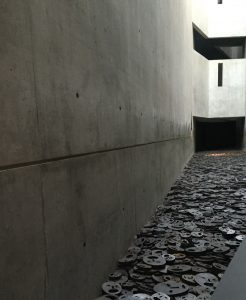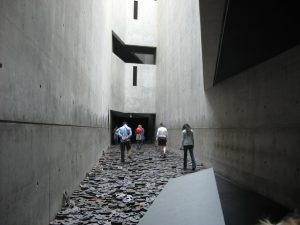Curators' Pick
Menashe Kadishman | Shalechet (Fallen Leaves), 1997 - 2001
![Shalechet [Fallen Leaves], 1997 – 2001, installation, Jewish Museum, Berlin](https://curatednow.ca/wp-content/uploads/2022/08/hl_b_4002_dpp4ptplr-1024x683.jpg)
Menashe Kadishman | Shalechet (Fallen Leaves), 1997 – 2001
Installation, Jewish Museum, Berlin
When we were young, we wanted our art to change the world. But when Hitler bombed Guernica, did Picasso’s painting have any effect? I thought that maybe some things of mine could do good. My sculptures didn’t change the war in Lebanon. Maybe art is not about changing anything. It’s about telling you reality. (Menashe Kadishman)
I will admit that I rely upon the term ‘contested narratives’ a bit too much: but when confronted with Kadishman’s installation, where his own personal history (as the child of two committed Zionists, in the early twentieth century) and larger tropes intersect, contradict and in some ways twist and transform in a manner that is more apropos to a fictional story than our expectations of ‘reality’, I feel I have no recourse.
Kadishman’s installation is “primarily associated with the Shoah (the Holocaust) [but] it holds a universal message against violence and human suffering. Kadishman himself notes that the work can relate to different tragedies such as World War I and Hiroshima. In part, Shalechet derives its meaning from the context of its presentation. For example, it took on a new meaning in 2018, when it was exhibited at the Memorial Hall dedicated to the victims of the Nanjing massacre in China.” (I include a link as this horror is lesser known, in the cacophony of savagery that is human history, like the many – repetitive, interchangeable, eternal – ‘faces’ silently wailing on the floor of Shalechet, growing old and rusting and still unheard….)
In Harry Turtledove’s Worldwar / Colonization books, he builds a world based upon what might happen if aliens invaded during the midst of World War II. He’s a fine writer of historical fiction, and I recommend any of his books (many are less fantastical, if that’s your taste): but in this one, as the aliens set down their motherships, and discover places like Auschwitz, Buchenwald, Dachau, Ravensbrück, Kraków-Płaszów – I’ll stop there, to preserve sensibilities – and many others, they are horrified that our species engages in wholesale, industrialized slaughter of each other. The aliens see us as monsters, beneath any kind of communication, if this is what we’ll do to ourselves. What is interesting, as well, in the book, is that the Jews of Łódź, in Poland, ally themselves with the invaders, as this is a finer option for survival than either the Nazis or the Communists….and one might ask what that says about humanity and about Menashe Kadishman’s art and appropriate, if alarming, resignation in the face of horror.
A video documenting the work, and people’s interactions with it, can be seen here. Perhaps you will find the noise as unsettling – as offensive – as I did, with people trodding upon the ‘faces’ of the ‘dead’ (but it’s not like we don’t do that everyday, literally and metaphorically….and that unsettling fracture is surely what Kadishman intended). In imagining walking over that floor, and my footfalls being loud and obtrusive in this meditative, almost funerary space, one of my favourite (dissident, and survivor of the Soviet gulag) poets – Anna Akhmatova – comes to mind, with her words, seemingly almost written for this space:
I have made a shroud for my friend,
Sad cloth.
She loves, loves blood
This Russian earth.
More facts about Shalechet: “Located in the Jewish Museum in Berlin, the installation consists of over 10,000 iron faces strewn across the hall. The iron discs are individually-cut, screaming faces, some reminiscent of the face in Edvard Munch’s The Scream (1893). The audience is prompted to walk on the anonymous faces while hearing the metal crack under their feet. The sound of metal-on-metal reverberates in the space recalling sounds of forced labor or of trains arriving at a concentration camp.
The name “Shalechet” (“Fallen Leaves” in English) comes from the poem “Soldiers”, written in the trenches of World War I by Italian poet Giuseppe Ungaretti: “We are like leaves on the trees in autumn”. Much like the turning leaves, the faces in the installation also change overtime: they are altered by rust and debris, and the molten metal hardens on the edges and inner spaces of the facial features. The leaf represents the cyclic transformation in nature, that can be compared to the different stages of life. In Shalechet, Kadishman provokes a potent experience to instill his humanist message, one that acknowledges collective human suffering and hopes for a new life in the spring.” (This quote, and the previous one describing this artwork, are from here).
But I should end with how the last book I read that centered upon the Holocaust was fiction: The Disappearance of Josef Mengele, by Olivier Guez, translated from the original French by Georgia de Chamberet.
Guez’ closing words in his book serve as an appropriate epilogue here, too: Every two or three generations, as memory fades and the last witnesses of past massacres disappear, reason is eclipsed and men return to propagate evil.
From all ill dreams defend our sight, from fears and terrors of the night.
And keep us on our guard. Be wary, man is a malleable creature, we must be wary of men.
Images are from the Jewish Museum in Berlin and The Art Story, respectively.
~ Bart Gazzola



